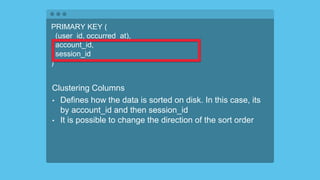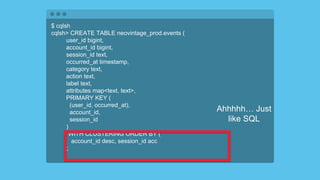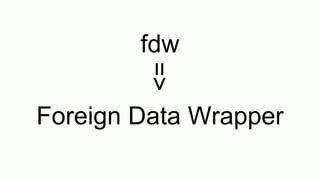From Postgres to Cassandra (Rimas Silkaitis, Heroku) | C* Summit 2016
- 1. Rimas Silkaitis From Postgres to Cassandra
- 2. NoSQL vs SQL
- 3. ||
- 4. &&
- 7. app cloud
- 10. $ git push heroku master Counting objects: 11, done. Delta compression using up to 8 threads. Compressing objects: 100% (10/10), done. Writing objects: 100% (11/11), 22.29 KiB | 0 bytes/s, done. Total 11 (delta 1), reused 0 (delta 0) remote: Compressing source files... done. remote: Building source: remote: remote: -----> Ruby app detected remote: -----> Compiling Ruby remote: -----> Using Ruby version: ruby-2.3.1
- 11. Heroku Postgres Over 1 Million Active DBs
- 12. Heroku Redis Over 100K Active Instances
- 13. Apache Kafka on Heroku
- 14. Runtime
- 15. Runtime Workers
- 16. $ psql psql => d List of relations schema | name | type | owner --------+----------+-------+----------- public | users | table | neovintage public | accounts | table | neovintage public | events | table | neovintage public | tasks | table | neovintage public | lists | table | neovintage
- 21. $ psql psql => d List of relations schema | name | type | owner --------+----------+-------+----------- public | users | table | neovintage public | accounts | table | neovintage public | events | table | neovintage public | tasks | table | neovintage public | lists | table | neovintage
- 22. Site Traffic Events * Totally Not to Scale
- 24. CREATE TABLE users ( id bigserial, account_id bigint, name text, email text, encrypted_password text, created_at timestamptz, updated_at timestamptz ); CREATE TABLE accounts ( id bigserial, name text, owner_id bigint, created_at timestamptz, updated_at timestamptz );
- 25. CREATE TABLE events ( user_id bigint, account_id bigint, session_id text, occurred_at timestamptz, category text, action text, label text, attributes jsonb );
- 26. Table
- 27. events
- 29. $ psql neovintage::DB=> e INSERT INTO events ( user_id, account_id, category, action, created_at) VALUES (1, 2, “in_app”, “purchase_upgrade” “2016-09-07 11:00:00 -07:00”);
- 31. Constraints • Data has little value after a period of time • Small range of data has to be queried • Old data can be archived or aggregated
- 32. There’s A Better Way
- 33. &&
- 35. $ psql psql => d List of relations schema | name | type | owner --------+----------+-------+----------- public | users | table | neovintage public | accounts | table | neovintage public | events | table | neovintage public | tasks | table | neovintage public | lists | table | neovintage
- 36. Why Introduce Cassandra? • Linear Scalability • No Single Point of Failure • Flexible Data Model • Tunable Consistency
- 38. I only know relational databases. How do I do this?
- 42. Postgres is Typically Run as Single Instance*
- 43. • Partitioned Key-Value Store • Has a Grouping of Nodes (data center) • Data is distributed amongst the nodes
- 44. Cassandra Cluster with 2 Data Centers
- 46. SQL-like [sēkwel lahyk] adjective Resembling SQL in appearance, behavior or character adverb In the manner of SQL
- 47. s Talk About Primary K Partition
- 48. Table
- 49. Partition Key
- 51. • 5 Node Cluster • Simplest terms: Data is partitioned amongst all the nodes using the hashing function.
- 53. Replication Factor Setting this parameter tells Cassandra how many nodes to copy incoming the data to This is a replication factor of 3
- 54. But I thought Cassandra had tables?
- 55. Prior to 3.0, tables were called column families
- 56. Let’s Model Our Events Table in Cassandra
- 58. We’re not going to go through any setup Plenty of tutorials exist for that sort of thing Let’s assume were working with 5 node cluster
- 59. $ psql neovintage::DB=> d events Table “public.events" Column | Type | Modifiers ---------------+--------------------------+----------- user_id | bigint | account_id | bigint | session_id | text | occurred_at | timestamp with time zone | category | text | action | text | label | text | attributes | jsonb |
- 60. $ cqlsh cqlsh> CREATE KEYSPACE IF NOT EXISTS neovintage_prod WITH REPLICATION = { ‘class’: ‘NetworkTopologyStrategy’, ‘us-east’: 3 };
- 61. $ cqlsh cqlsh> CREATE SCHEMA IF NOT EXISTS neovintage_prod WITH REPLICATION = { ‘class’: ‘NetworkTopologyStrategy’, ‘us-east’: 3 };
- 62. KEYSPACE == SCHEMA • CQL can use KEYSPACE and SCHEMA interchangeably • SCHEMA in Cassandra is somewhere between `CREATE DATABASE` and `CREATE SCHEMA` in Postgres
- 63. $ cqlsh cqlsh> CREATE SCHEMA IF NOT EXISTS neovintage_prod WITH REPLICATION = { ‘class’: ‘NetworkTopologyStrategy’, ‘us-east’: 3 }; Replication Strategy
- 64. $ cqlsh cqlsh> CREATE SCHEMA IF NOT EXISTS neovintage_prod WITH REPLICATION = { ‘class’: ‘NetworkTopologyStrategy’, ‘us-east’: 3 }; Replication Factor
- 65. Replication Strategies • NetworkTopologyStrategy - You have to define the network topology by defining the data centers. No magic here • SimpleStrategy - Has no idea of the topology and doesn’t care to. Data is replicated to adjacent nodes.
- 66. $ cqlsh cqlsh> CREATE TABLE neovintage_prod.events ( user_id bigint primary key, account_id bigint, session_id text, occurred_at timestamp, category text, action text, label text, attributes map<text, text> );
- 67. Remember the Primary Key? • Postgres defines a PRIMARY KEY as a constraint that a column or group of columns can be used as a unique identifier for rows in the table. • CQL shares that same constraint but extends the definition even further. Although the main purpose is to order information in the cluster. • CQL includes partitioning and sort order of the data on disk (clustering).
- 68. $ cqlsh cqlsh> CREATE TABLE neovintage_prod.events ( user_id bigint primary key, account_id bigint, session_id text, occurred_at timestamp, category text, action text, label text, attributes map<text, text> );
- 69. Single Column Primary Key • Used for both partitioning and clustering. • Syntactically, can be defined inline or as a separate line within the DDL statement.
- 70. $ cqlsh cqlsh> CREATE TABLE neovintage_prod.events ( user_id bigint, account_id bigint, session_id text, occurred_at timestamp, category text, action text, label text, attributes map<text, text>, PRIMARY KEY ( (user_id, occurred_at), account_id, session_id ) );
- 71. $ cqlsh cqlsh> CREATE TABLE neovintage_prod.events ( user_id bigint, account_id bigint, session_id text, occurred_at timestamp, category text, action text, label text, attributes map<text, text>, PRIMARY KEY ( (user_id, occurred_at), account_id, session_id ) ); Composite Partition Key
- 72. $ cqlsh cqlsh> CREATE TABLE neovintage_prod.events ( user_id bigint, account_id bigint, session_id text, occurred_at timestamp, category text, action text, label text, attributes map<text, text>, PRIMARY KEY ( (user_id, occurred_at), account_id, session_id ) ); Clustering Keys
- 73. PRIMARY KEY ( (user_id, occurred_at), account_id, session_id ) Composite Partition Key • This means that both the user_id and the occurred_at columns are going to be used to partition data. • If you were to not include the inner parenthesis, the the first column listed in this PRIMARY KEY definition would be the sole partition key.
- 74. PRIMARY KEY ( (user_id, occurred_at), account_id, session_id ) Clustering Columns • Defines how the data is sorted on disk. In this case, its by account_id and then session_id • It is possible to change the direction of the sort order
- 75. $ cqlsh cqlsh> CREATE TABLE neovintage_prod.events ( user_id bigint, account_id bigint, session_id text, occurred_at timestamp, category text, action text, label text, attributes map<text, text>, PRIMARY KEY ( (user_id, occurred_at), account_id, session_id ) ) WITH CLUSTERING ORDER BY ( account_id desc, session_id acc ); Ahhhhh… Just like SQL
- 76. Data TypesTypes
- 77. Postgres Type Cassandra Type bigint bigint int int decimal decimal float float text text varchar(n) varchar blob blob json N/A jsonb N/A hstore map<type>, <type>
- 78. Postgres Type Cassandra Type bigint bigint int int decimal decimal float float text text varchar(n) varchar blob blob json N/A jsonb N/A hstore map<type>, <type>
- 79. Challenges • JSON / JSONB columns don't have 1:1 mappings in Cassandra • You’ll need to nest MAP type in Cassandra or flatten out your JSON • Be careful about timestamps!! Time zones are already challenging in Postgres. • If you don’t specify a time zone in Cassandra the time zone of the coordinator node is used. Always specify one.
- 81. General Tips • Just like Table Partitioning in Postgres, you need to think about how you’re going to query the data in Cassandra. This dictates how you set up your keys. • We just walked through the semantics on the database side. Tackling this change on the application-side is a whole extra topic. • This is just enough information to get you started.
- 83. Runtime Workers
- 84. Runtime Workers
- 86. fdw
- 87. We’re not going to go through any setup, again…….. https://bitbucket.org/openscg/cassandra_fdw
- 88. $ psql neovintage::DB=> CREATE EXTENSION cassandra_fdw; CREATE EXTENSION
- 89. $ psql neovintage::DB=> CREATE EXTENSION cassandra_fdw; CREATE EXTENSION neovintage::DB=> CREATE SERVER cass_serv FOREIGN DATA WRAPPER cassandra_fdw OPTIONS (host ‘127.0.0.1'); CREATE SERVER
- 90. $ psql neovintage::DB=> CREATE EXTENSION cassandra_fdw; CREATE EXTENSION neovintage::DB=> CREATE SERVER cass_serv FOREIGN DATA WRAPPER cassandra_fdw OPTIONS (host ‘127.0.0.1'); CREATE SERVER neovintage::DB=> CREATE USER MAPPING FOR public SERVER cass_serv OPTIONS (username 'test', password ‘test'); CREATE USER
- 91. $ psql neovintage::DB=> CREATE EXTENSION cassandra_fdw; CREATE EXTENSION neovintage::DB=> CREATE SERVER cass_serv FOREIGN DATA WRAPPER cassandra_fdw OPTIONS (host ‘127.0.0.1'); CREATE SERVER neovintage::DB=> CREATE USER MAPPING FOR public SERVER cass_serv OPTIONS (username 'test', password ‘test'); CREATE USER neovintage::DB=> CREATE FOREIGN TABLE cass.events (id int) SERVER cass_serv OPTIONS (schema_name ‘neovintage_prod', table_name 'events', primary_key ‘id'); CREATE FOREIGN TABLE
- 92. neovintage::DB=> INSERT INTO cass.events ( user_id, occurred_at, label ) VALUES ( 1234, “2016-09-08 11:00:00 -0700”, “awesome” );
- 94. Some Gotchas • No Composite Primary Key Support in cassandra_fdw • No support for UPSERT • Postgres 9.5+ and Cassandra 3.0+ Supported














































![SQL-like
[sēkwel lahyk]
adjective
Resembling SQL in appearance,
behavior or character
adverb
In the manner of SQL](https://image.slidesharecdn.com/2016-cassandra-summit-from-postgres-to-cassandra-160926060610/85/From-Postgres-to-Cassandra-Rimas-Silkaitis-Heroku-C-Summit-2016-46-320.jpg)
















































